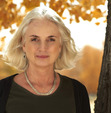Julene Bair's Blog, page 4
September 6, 2018
Our Turn at this Earth: Old Fools in the Wilderness
“Our Turn at this Earth” airs weekly on HIgh Plains Public Radio
https://www.julenebair.com/wp-content/uploads/2018/09/38-Old-Fools-Final-Mix.mp3
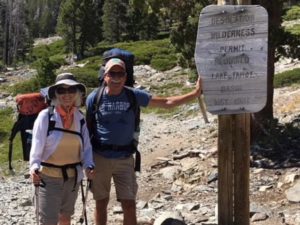
The Old Fools
Last month, my partner and I, having become mutually deluded, decided to go backpacking in the Sierra Nevada Mountains. Al had done this many times as a younger man. Now 67, he likes to remind me that he is two whole years my junior. I had only backpacked a few times in that long life of mine, but with visions of diving into blue mountain lakes, I thought that a three-mile jaunt into the Sierras should be no problem.
Perhaps the fact that we nearly toppled over while putting on our packs should have given us pause. But intrepid fools that we are, we started up the trail and didn’t look back. By the time the enticingly blue waters of Lake of the Woods came into view, we were barely able to take another step. We still had a half mile to go, all of it down a steep hill. As I limped along, my right hip threatening to give way, I didn’t dare ask out loud the question lodged in my mind. “How will I ever get out of here?”
And yet, I couldn’t resist the lake’s siren call. Not long after dropping my pack in our campsite and falling on top of it I found myself barely upright again, inching across slippery rocks into the water. I delighted in that swim just as much as I remembered doing when I last visited the High Sierras as an agile twenty-six year old. As I dripped dry in the late afternoon sun, the only visible sign I saw of other humans was an orange tent among boulders on the far shore. In the nearer distance, a tiny dot of a duck trailed a vee across the mountain range mirrored in the lake’s surface. A frog leapt, drawing my vision onto the bank, where a western sugar pine tree rose above me, its bark as symmetrical as the scales of a lizard. I found that tree stunningly beautiful.
The words of John Norman, a soil scientist I’d interviewed recently, came to mind. “It’s like it’s taking care of you,” he’d said, describing how he felt wandering on a wild prairie. I wasn’t kidding myself. My hip still ached, and I really didn’t know how I was going to get out of that place. But John hadn’t meant that we could venture in the wild without incurring risk. What he meant was that nature takes care of our spirits, which crave natural beauty as much as our bodies crave food.
After a couple of careful days nursing our ailing joints and staying closer to camp than either of us wanted, Al and I climbed out of that valley with ease. What we couldn’t believe was the two and a half miles of rock-strewn trail we’d climbed on our way in. We’d run the risk of injury just for a taste of wildness. Old fools that we still were, we no sooner reached the car than we began planning our next trip.
August 30, 2018
Our Turn at this Earth: John Norman – A Soil Scientist Speaks His Soul
“Our Turn at this Earth” airs weekly on HIgh Plains Public Radio.
https://www.julenebair.com/wp-content/uploads/2018/09/37-John-Norman-Final-Mix.mp3
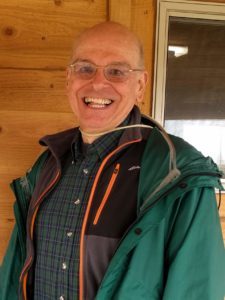 This May, when I paid a visit to the North Dakota farm of the well-known Soil Health advocate, Gabe Brown, I felt particularly blessed to take part in a conversation with the insightful soil scientist, John Norman. Although he retired some time ago from university teaching and research, John had agreed to oversee a study of the soils on Gabe’s farm.
This May, when I paid a visit to the North Dakota farm of the well-known Soil Health advocate, Gabe Brown, I felt particularly blessed to take part in a conversation with the insightful soil scientist, John Norman. Although he retired some time ago from university teaching and research, John had agreed to oversee a study of the soils on Gabe’s farm.
He was motivated in this research by his understanding of prairies and the soils beneath them as living systems. “When we moved onto this continent,” he said, “we could pick and choose and rip stuff apart and it was so beautifully put together by nature that we thought it was an infinite resource. Well now we know that it’s not.” A system, he explained, is like a spider’s web. Pulling one filament affects the entire web. He argued that we can no longer afford to think of farmers as “separate entities” or of cities as separate from the ecology that surrounds and supports them. “If we don’t change our mindset,” John continued, “we’re going to extinguish ourselves.”
Gradually, listening to John, I realized that I was in the company of a scientist who had all of the technical knowledge one could acquire on the subject of soil, yet who also took a spiritual view of the human relationship with land. He described the hours he spent doing research on a prairie tract near Lincoln, Nebraska that’s never been tilled. “Its’ never had houses or roads or anything on it that anyone knows of, ever,” he said. “It’s a big prairie, not just a little remnant someplace that’s a postage stamp, but a big area – and it just infuses your being. When you step on that soil, it’s like it’s holy.”
Thrilled to be talking with someone who feels as moved as I do by prairie vastness, I asked, “Were there many people like you at UNL?”
“I wasn’t like me at UNL,” John said, explaining that scientists, rather than being systems thinkers, are “…single variable people. They think of one thing at a time. Only one thing. And they try to convince themselves they’re holding everything else constant. But you can’t hold anything constant in the real world.”
“Academia,” he said, “runs on money like everything else in our society. … That’s why in agriculture, everything’s about the yield. The quality often goes this way,” he said, pointing his thumb down. He then pointed it up. “While the yield goes that way.”
I told John how encouraged I’d been to see the excitement on the faces of farmers in the Soil Health movement videos online. I said, “I think in the soul of every farmer there is this desire to be connected to the soil.”
“It’s in the soul of every person,” John said, “but the problem is they aren’t listening to their souls.”
August 23, 2018
Our Turn at this Earth: Saving the Farm to Save the World
“Our Turn at this Earth” airs weekly on HIgh Plains Public Radio.
https://www.julenebair.com/wp-content/uploads/2018/09/36-Saving-The-Farm-Final-Mix.mp3
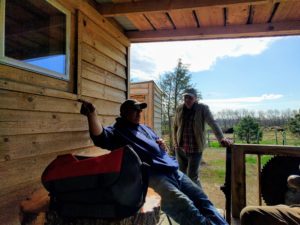 “This farming has gotten so industrialized and out of hand,” Gabe Brown said. We were sitting in the shade on his North Dakota regenerative farm, watching several hundred chickens scratching in a field of mixed cover crops. They provided ready contrast to the ills Gabe was describing. Most chickens these days live in cages so small they can’t even spread their wings.
“This farming has gotten so industrialized and out of hand,” Gabe Brown said. We were sitting in the shade on his North Dakota regenerative farm, watching several hundred chickens scratching in a field of mixed cover crops. They provided ready contrast to the ills Gabe was describing. Most chickens these days live in cages so small they can’t even spread their wings.
Abe Collins, a soil advocate colleague of Gabe’s, felt he understood the root of the problem. “Farmers,” he said, “are just paid for food. That’s how you set up extinction. Just pay for one thing and to hell with soil and biodiversity.” If producers were restoring soil health and water quality, he argued, they were performing a public service and should be paid for that.
Except farmers created the unhealthy soil and dirty water in the first place, I couldn’t help pointing out.
Abe responded quickly. “A social-economic structure that’s ten thousand years old did that. It was not…to say that the individual farmer…”
John Norman, the soil scientist Abe had enticed out of retirement to study the soils on Gabe’s farm, pointed out that if a factory chose to eliminate maintenance, it would be out of business in no time. Yet farmers in our economic system have to use up the soil and water necessary to future production because they are under so much pressure to maximize yield.
Abe informed us that the shekel of Mesopotamia was just “a silver equivalent to a bushel of barley.” But other things also needed to be weighed and paid for now, like flood control and carbon sequestration and groundwater recharge and purification.
We all had a personal stake in this conversation. John had spent his career watching soil eroding, its structure collapsing, and its nutrients being depleted. When Gabe first began farming, he underwent four years of drought and hail. Seeing all of the life that returned to the soil during that period of little tillage and few pesticides caused him to rethink the way he farmed. I had watched the Ogallala Aquifer, the water of my homeland, dwindle and become contaminated by nitrates and herbicides. But it was Abe whose emotions were most engaged at the moment.
He said, “I’ve been a dairy farmer who couldn’t buy a five-year-old kid a $20 bike, working eighty hours a week. I never forget that moment. It chokes me up now thinking about it. And this year I think USDA says that eighty percent of ranch and farming income in the US is off-farm income. Should the farmers just do this because it’s the right thing? No! No. The majority are not the mega-farmers that you wag your finger at for making too much money. Farmers are going extinct, and they’re the people who can regenerate the world that we need.”
I had to agree. No more eloquent words had ever been spoken on behalf of farmers, or the world.
August 16, 2018
Our Turn at this Earth: The Missing Loop
“Our Turn at this Earth” airs weekly on HIgh Plains Public Radio.
https://www.julenebair.com/wp-content/uploads/2018/09/35-The-Missing-Loop-Final-Mix.mp3
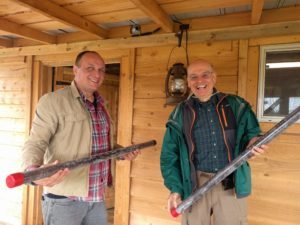
Abe Collins and John Norman
By lucky coincidence, my visit this May to the North Dakota farm of the remarkable soil health advocate Gabe Brown corresponded with a study being led by two other remarkable men. One of them was Abe Collins, who has spent most of his life raising cattle and sheep. He is now mapping the soils on regenerative farms such as Gabe’s, hoping to create what he calls a “translation utility.” Given information provided by this utility, cities and taxpayers could pay farmers for environmental outcomes such as flood control and groundwater recharge. To this end, he launched a company called LandStream and the current ambitious study, budgeted at $600,000 for the first year.
He held up a four-foot tube containing a core sample taken that morning. He showed me how just inserting the tube had pressed all of the soil down into the bottom half. Abe’s colleague, Dr. John Norman, said he’d never seen a core compress by a factor of two.
“And that’s over fifty years,” Abe put in. Now retired, John had spent most of those years developing soil measurement systems at the Universities of Nebraska and Wisconsin. Soils are naturally about fifty percent voids, he explained, but on conventional farms, repeated tillage and chemical applications reduce the organic matter, causing the soil to lose its porosity. In response, John explained, farmers try to do with tillage “what nature would do on its own if left alone. … microfauna and mezofuana burrowing in, making spaces in there, then decaying.”
The high percentage of pore space they were seeing on Gabe’s farm demonstrated not only that his soil could store every drop of rain that fell but, as Abe explained, anyone who farmed in this way was providing flood control and groundwater restoration services to the community.
As one example of the marketable outcomes of regenerative farming, Gabe Brown cited Ohio farmer David Brandt’s work with the city of Columbus when it was having problems with nitrate pollution in its drinking water. Brandt convinced the city to pay farmers upstream to plant cover crops, which prevented nutrient runoff, thereby allowing the city to avoid building an expensive new treatment plant.
Carbon sequestration is another outcome that could prove lucrative to regenerative farmers. Conventional tillage exposes carbon stored in the soil, returning it to the atmosphere as carbon dioxide. Regenerative farming, on the other hand, leaves the soil intact and increases organic matter, thereby increasing the soil’s carbon-holding capacity.
All great, except, as Abe said, “Our entire social and economic structure is missing a feedback loop allowing us to read the land.” If such information were readily available, we could adjust our policies and economics accordingly. That missing loop is what he hopes to fix.
August 9, 2018
Our Turn at this Earth: Nature Won Them Over
“Our Turn at this Earth” is broadcast Thursdays at 6:44 pm on HPPR.
https://www.julenebair.com/wp-content/uploads/2018/08/34-Nature-Won-Final-Miix.mp3
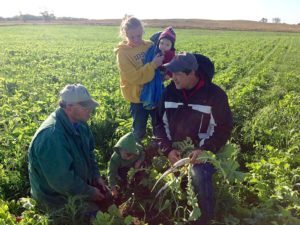
USDA NRCS SOUTH DAKOTA
Often in our culture, when thinking about land, we think only about how much money we can make farming its soils, grazing its grasses, mining its minerals, or harvesting its trees. We think this way, understandably, because we need to make a living and secure our futures, but in that pursuit, we sometimes fail to notice what the land already gives us in its natural state.
I’ve spent the better part of my writing career trying to describe why standing on a mild green buffalo grass prairie, or hearing a meadowlark sing, or noticing the way light suffuses the plains landscape lifts my spirits. I go to this effort because in order for us to make choices that favor the health of our natural systems, we need to recognize our connection with them. If we feel connected to nature, then we feel any harm done to it in our own beings—right now, not decades in the future when we might realize we are now ill, or our grandchildren are being born with birth defects, or our food systems have collapsed.
I first became aware of my affinity with nature in my young adulthood, camping in western wildernesses. In particular, I fell under the spell of the breathtakingly clear blue waters of the Sierra Nevada mountains. They are why, when I went home to Kansas and farmed with my father, I couldn’t watch the finite waters of the Ogallala aquifer gush from our irrigation pipes without imagining my own blood pouring onto the ground. Whenever the odors of herbicides and chemical fertilizers drifted over the farmstead, I thought of all the life in the soil that surely couldn’t withstand such an onslaught and felt as if my own cells were under attack.
Of late, I’ve been excited to learn about the Soil Health movement, because in the faces and words of the many farmers participating in it, I see that nature has won them over much the way it won me over when I was a young woman exploring western mountains and deserts. As earthlings, we are part of the earth, but many of us don’t think about this much—not until, like me, they dive into a mountain lake, or live for a while in a wild and beautiful place, or, like those farmers, hold a clump of rich soil, teaming with worms and exuding those smells that we humans are uniquely wired to find intoxicating.
Those farmers beam with rightful pride at having restored their soil to health. They undertook that work not only to increase their profit margins and the longevity of their operations, but because examples they’d seen of truly healthy soil on others’ farms ignited their passion to restore their own soil. In that spreading passion lies the greatest hope I’ve seen to date for the future of earth’s natural systems, and for ourselves.
August 2, 2018
Our Turn at this Earth: Could Regenerative Agriculture Save the Ogallala Aquifer?
“Our Turn at this Earth” is broadcast Thursdays at 6:44 pm on HPPR.
https://www.julenebair.com/wp-content/uploads/2018/08/33-Could-Regenerative-Final-Mix.mp3
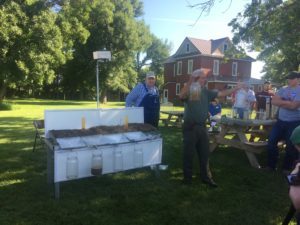
Could regenerative agriculture save the Ogallala Aquifer? That’s the question I first asked myself some months ago when I began learning about the Soil Health movement. I’d seen a video of Ray Archuleta, the agronomist who spearheaded the movement, demonstrating how non-tilled versus conventionally farmed soils absorb water. When he placed a clump of soil from a field that had been tilled year after year into a jar of water, it immediately fell apart and turned the water brown, while a clump from a field farmed without tillage held together for over 24 hours. In another test, simulated rain just sat on top of the soil from the tilled field, while it thoroughly saturated the non-tilled soil. Ray attributed these differences to there being more pore spaces in the non-tilled sample.
Excited by the implications for water conservation, I paid a visit to the well-known North Dakota soil health advocate Gabe Brown, who showed me how that porosity occurs. In a field where he’d harvested corn the previous fall, then planted a cover crop of rye and hairy vetch, he pulled a vetch plant from the ground and pointed to chunks of soil that clung to its roots. Plant roots, he explained, secrete what he called exudates, which serve as food for microbes and other soil life, including fungi. The fungi return the favor by exuding glomalin, a sort of biological glue that allows soil to stick together. The resulting chunks of soil, known as aggregates, create the pore spaces that allow water to infiltrate and be retained.
Fungi and other soil organisms also bring nutrients and water to plants from further away than their roots can reach. But tillage, herbicides, and chemical fertilizers harm those organisms and remove organic matter, also critical to water retention. By farming with diverse cash and cover crops, never tilling or applying chemical fertilizers, and seldom applying herbicides, Gabe had increased the organic matter in his soil from less than two percent to greater than six percent. Consequently, he said it could now hold three times as much water as it used to do.
This feature of healthy soil is especially important when it doesn’t rain enough. Although he’d received only 5.8 inches of rainfall the previous year, “I still grew things,” he said. “We had sedan grass cover crops eight feet tall.” When the local FSA agent encouraged him to apply for disaster payments, he said, “Why? I don’t have a disaster.”
“Just think of the resiliency for a farmer or rancher if they build soil like this,” Gabe continued. I nodded slowly, hoping to absorb all he was sharing at least half as well as his soil absorbed rain. This visit had been a rare opportunity and I was driven to pass the information on. Imagine what the wide adoption of these regenerative techniques could mean for the Ogallala Aquifer. They were the most effective water conservation tools ever conceived.
July 26, 2018
Our Turn at this Earth: A Soil Health Tour
“Our Turn at this Earth” is broadcast Thursdays at 6:44 pm on HPPR.
https://www.julenebair.com/wp-content/uploads/2018/08/32-Soil-Health-Tour-Final-Mix.mp3
 Gabe Brown threw a drain spade into the bed of his pickup, and invited me to hop in the passenger seat. I’d arrived at his North Dakota farm earlier that morning and was getting a crash course in the art and science of regenerative agriculture from one of its foremost practitioners.
Gabe Brown threw a drain spade into the bed of his pickup, and invited me to hop in the passenger seat. I’d arrived at his North Dakota farm earlier that morning and was getting a crash course in the art and science of regenerative agriculture from one of its foremost practitioners.
The first field we drove to was not one of his, but that of a large organic farmer. “A very good operator,” Gabe said, “very diverse crop rotation, but heavy tillage.” He placed his foot on the spade and gave it a good push. It sank two-thirds its length – about as deep, Gabe explained, as the most recent tillage. He lifted up a clump of soil. “See how dry that is? See how tiny the particles are?” As he rubbed the soil between his fingers it turned to powder and blew away. “When rain hits that, what do you think will happen?”
“It won’t soak in? It will just run off?” Right-o. The most destructive thing you can do to soil, Gabe had explained that morning, is till it. I’d had a hard time wrapping my head around this premise, since I’d grown up watching my father get the cultivator out every time he spotted a weed. Gabe had patiently explained that tilling kills beneficial organisms such as earthworms and fungi, and it destroys what he called “armor,” the mulch of dried plant life that cools the soil, protects it from erosion, and feeds those organisms.
But stopping tillage is not enough. To build healthy soil, Gabe had also explained, you need to plant cover drops. In the next field he showed me, an industrial, no-till farmer had harvested corn in the fall and left the stubble, which was good. But “look,” Gabe said, “nothing green and growing, not even weeds.” This left organisms that depend on the substances exuded by living roots nothing to eat. Although Gabe’s shovel went in all the way, the soil he lifted had a hard, platey structure. It had a pungent odor too. Gabe said this came from a preponderance of bacteria. Industrial no-till, he explained, depends on synthetic chemicals, which upset the balance between fungi and bacteria.
In the next field, his own, Gabe toed aside a thick carpet of dried plant life. “Look at that armor,” he said. Earthworm castings covered the ground beneath the “armor.” He’d also grown corn last year, but he had inter-seeded it with sweet clover as a nitrogen source and had not used any chemicals at all. He’d then planted a cover crop of rye and hairy vetch, which was just coming out of dormancy.
The soil in this field was darker than in the others. It clumped when he squeezed it, and when he rubbed it between his fingers, it didn’t turn to dust and blow away, but crumbled and dropped straight to the ground. “See?” Gabe said. “Like black cottage cheese. That’s what you want to see.” I’ll share more of what I learned from Gabe and his soil next week.
July 12, 2018
Our Turn at this Earth: “I Grow Things,” a Visit with Gabe Brown
“Our Turn at this Earth” is broadcast Thursdays at 6:44 pm on HPPR
https://www.julenebair.com/wp-content/uploads/2018/08/31-A-Visit-With-Gabe-Final-Mix.mp3
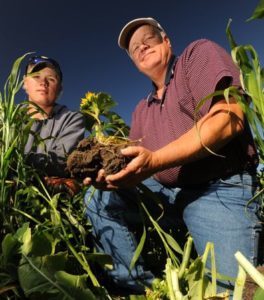
Gabe and Paul Brown
I love the wide-open, top-of-the-world feeling I get whenever I’m on the Great Plains.. Last month, I was able to relish that feeling once again. After flying into Bismarck, North Dakota, I drove out to Gabe Brown’s 5,000 acre ranch and farm. Gabe showed me to a chair on the porch of a one-room cabin he’d built for meetings with visitors. A prominent leader in the Soil Health movement, he told me that a group or an individual comes by almost every day to learn about his regenerative farming and grazing techniques.
“So tell me what you’re interested in,” he said.
I told him that until my family sold our western Kansas irrigated farm in 2006, we had done our part in depleting the Ogallala Aquifer, the largest source of groundwater in this country. That farm and others like it were continuing to drain the aquifer, which seemed wrong to me. For a long time, I’d been looking for some positive news to share about how the aquifer could be saved. And then, online, I’d come across contrasting pictures of what happened in Gabe’s and a neighbor’s field after a freak thirteen inch rainstorm in 2009. The neighbor’s field had turned into a lake, while all of that rain had just soaked into Gabe’s soil.
“That’s when a light went off in my head,” I told him. “If our soil had held water like that, we may never have drilled our first well.”
“Yep,” Gabe said. “The amount of rain you get is irrelevant. What’s important is how much moisture can penetrate your soil and how much your soil can hold due to organic matter and biology.” By “biology” he meant the millions of organisms that live in the soil, many invisible to the naked eye. According to a USDA bulletin, an acre of healthy soil contains anywhere from 2,500 to more than 5,000 pounds of these organisms. Tillage destroys much of that life, as does failing to feed it through the root systems of living plants, and with the organic matter that plants leave behind. That’s why Soil Health advocates like Gabe never till their fields, and why they grow cover crops—to nurture that complex life system belowground so that it can feed and hydrate their cash crops.
Gabe said, “People ask, ‘Why is your place different?’ I grow things! My neighbors, they’re only growing things for ninety or a hundred days of the year.”
“I can just hear my dad now,” I said. “‘Cover crops won’t work in our dry old country. They’ll suck up all the moisture you need to grow your crop.’”
“That’s not how nature functions,” Gabe said. Over the next couple of hours, he drove me around his farm, showing me how it did function. I’ll share more of what I learned next week.
July 5, 2018
Our Turn at this Earth: The Soil Health Movement
“Our Turn at this Earth” is broadcast Thursdays at 6:44 pm on HPPR
https://www.julenebair.com/wp-content/uploads/2018/08/30-Soil-Health-Movement-Final-Mix-1.mp3
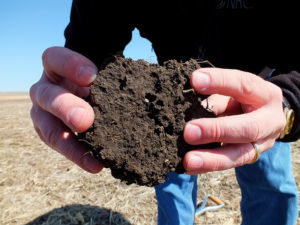
USDA National Resource Conservation Services
I had read something about a Montana farmer who was using sweetclover as a cover crop in his wheat. The details are long lost to me. He may have been inter-seeding the clover with the wheat, or establishing it over a season or two, then turning it under before he planted his cash crop. Whatever his method, the clover, being a legume, fixed nitrogen in the soil. I thought, wouldn’t it be great if we didn’t have to use that nasty anhydrous ammonia fertilizer anymore? When applying it we had to wear goggles lest it burn our eyes. Breathing the acrid mist could be deadly. And farm magazines often ran stories about chemical fertilizer leaching into and polluting ground and surface water. I could hardly contain my excitement.
But when I suggested to my father that he let me experiment with clover and wheat in one of our fields, he pooh-poohed the idea. It wouldn’t work in our part of the country, he said. The clover would sap moisture from the soil and the wheat would fail. We needed to kill weeds, not grow them. Today I think I may have given up too easily. Rather than continuing to look for ways to farm more sustainably, I decided to go back to school and study writing. That was my true passion.
I soon discovered, however, that writing wasn’t my only passion. Over the next thirty years, I never stopped thinking about the soil and water of home. Meanwhile, U.S Geological Survey studies revealed that the widespread use of anhydrous ammonia fertilizer was causing more and more nitrates to show up in the Ogallala Aquifer and in the drinking water it supplied to High Plains towns .
But, over those same three decades, a “soil health” movement began taking root in the minds of farmers all over the world. They began planting mixed cover crops that, in turn, sent roots down to varying depths into the earth. Now the practice is even spreading to our semi-arid plains. Recently, I watched several video talks and interviews with soil health advocates Ray Archuleta, also known as “The Soil Guy,” and North Dakota farmer and rancher Gabe Brown, who has been employing cover crops and other regenerative techniques ever since the mid-1990s.
Misters Archuleta and Brown explain that cover crops, combined with now common no-till practices, do not deplete soil moisture the way my father feared. The additional biomass fosters earthworms, mycorrhizae fungi, and a host of microbes, which interact with the roots and break down the plentiful organic matter, making the soil porous and rich. Live, fertile soil like this can hold many times more water than tilled fields where there is no cover and where chemicals are used to fertilize and combat pests.
This is what these men are saying. I am as excited as I was in the 1980s, when I first read about sweetclover as a cover crop. And I’m eager to find out more. I’ll keep you posted on what I learn.
June 28, 2018
Our Turn at this Earth: Dream Women
“Our Turn at this Earth” is broadcast Thursdays at 6:44 pm on HPPR
//www.julenebair.com/wp-content/uploads/2018/07/29-Dream-Women-Final-Mix.mp3
[image error]
“American Gothic,” Grant Wood
In the dream, a little girl stands beside a row of women. The women are dressed demurely in dark dresses such as the ones my mother’s mother wore—navy blue with tiny polka dots or dark green bordering on black. They sit erect in straight-backed chairs, their hands folded in their laps. The girl moves from one woman to the next, asking, “Do you have any magic?” Each in turn smiles indulgently at the girl. “Oh my! Why no, dear.”
The little girl, of course, was me. And those women, in their dourness and denial? They were the distilled, reticent essence of the women I grew up around. My mother and her friends didn’t wear dark dresses. They wore bright ones, and laughed often. I picture them at ladies’ club meetings, holding fancy saucers with cup rings on them to keep their delicate cups from splashing coffee onto the hostess’s homemade cookies. But there were certain things they never talked about, certain things that they would go to their death beds never having shared.
They were stoic. That word, often applied to pioneers and their descendants, brings “American Gothic,” the famous Grant Wood painting, to mind. An elderly farmer stands as erect as the pitchfork he holds at his side, his wife beside him. Studying an image of that painting just now, I note that the farmer sternly faces forward, looking the viewer in the eye. But his wife, although her expression is also severe, looks slightly off to the side. She is not connected to the viewer, and I would venture, she is not that in touch with herself. She seems, in fact, to be somewhere else entirely.
My mother was not severe, but she was emotionally inaccessible. I knew not to ask her personal questions. She had grown up in a family who didn’t share their feelings. Therefore I was growing up in such a family.
I never realized this was unusual until my mid-thirties when I went back to college and joined a women’s writing group. No fancy cups and saucers there. We met at a Mexican restaurant. Over enchiladas and margaritas, we critiqued one another’s short stories, and discussed… what else but the intimate details of our private lives? That’s how women are. We can meet at a party and be sharing our personal stories within minutes. It is how we connect, how we grow, and how we learn.
What caused the farm women of my childhood to withhold so much of themselves? Lacking sounding boards for their emotions on remote homesteads, had they forgotten they had emotions?
I don’t know. All I do know, thanks to those women I met when I returned to college, is what I had been missing until then. The magic in that dream, the magic that each woman in turn claimed not to have? It was not the power to feel. We all feel. It was the power to know their feelings.

